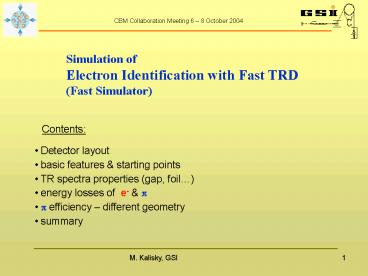Simulation of PowerPoint PPT Presentation
Title: Simulation of
1
Simulation of Electron Identification with Fast
TRD (Fast Simulator)
- Contents
- Detector layout
- basic features starting points
- TR spectra properties (gap, foil)
- energy losses of e- ?
- ? efficiency different geometry
- summary
2
Layout of the simulated detector
- radiator (regular)
- 25 ?m Mylar foil
- gas volume (Xe/CO2)
- Standard Geometry (SG)
- 100 Polypropylene foils
- foil - 10 ?m
- gap 90 ?m
- XeCO2 (85/15), 6mm
- p 2 GeV/c (e, ?)
- 90 electron efficiency
3
- Basic features
- MC based standalone code
- microscopic simulations
- no real stuff (rate, space charge etc)
- Tuned with help of ALICE TRD simulations
measurements ref.1 - production of the TR in the radiator ref.2
- absorption of the TR in the radiator, Mylar foil
and gas volume - energy losses of e and ? in the gas volume (with
input from GEANT3) - Likelihood distributions
- ? efficiency computation
4
ALICE TRD - Simulations Measurements
- Features
- 2GeV/c
- 4 Detectors
- 3.7 cm XeCO2 (85/15)
- PO fibres (INV6)
- momentum dependence
- not reproduced by simulation
ref. NIM A522 (2004) 40
5
TR spectrum
- SG
- ltNgt 0.8 / e
- ltEgt 8.8 keV
- ltEabgt 6.4 keV
- ltEescgt 12.5keV
6
TR properties - Foil
thicker foil more material
7
TR properties - Gap
8
TR properties Detector thickness
9
TR properties No. of foils
thicker radiator more material
10
Energy losses Likelihood
11
Energy losses Measurements Simulations
Data from testbeam July 2004, GSI
12
Pion Efficiency (I)
13
Pion Efficiency (II)
1.2
14
Summary
- What was done
- scan over basic parameters of the TR
- estimation of the Pion Efficiency for given TRD
geometry - 100 200 pion rejection can be reached
- What needs to be done
- more detailed simulations(rate effectsetc.)
- test the properties of such a detector in a beam
with different radiators - (if possible)
- concerning CBM framework digitizer..(standalone
, or GEANT4) ..?
Ref 1 Nucl. Instrum. Meth. A519 (2004) 508 2
C.W. Fabjan et al., Phys. Lett. B 57, 483,
(1975)
PowerShow.com is a leading presentation sharing website. It has millions of presentations already uploaded and available with 1,000s more being uploaded by its users every day. Whatever your area of interest, here you’ll be able to find and view presentations you’ll love and possibly download. And, best of all, it is completely free and easy to use.
You might even have a presentation you’d like to share with others. If so, just upload it to PowerShow.com. We’ll convert it to an HTML5 slideshow that includes all the media types you’ve already added: audio, video, music, pictures, animations and transition effects. Then you can share it with your target audience as well as PowerShow.com’s millions of monthly visitors. And, again, it’s all free.
About the Developers
PowerShow.com is brought to you by CrystalGraphics, the award-winning developer and market-leading publisher of rich-media enhancement products for presentations. Our product offerings include millions of PowerPoint templates, diagrams, animated 3D characters and more.

